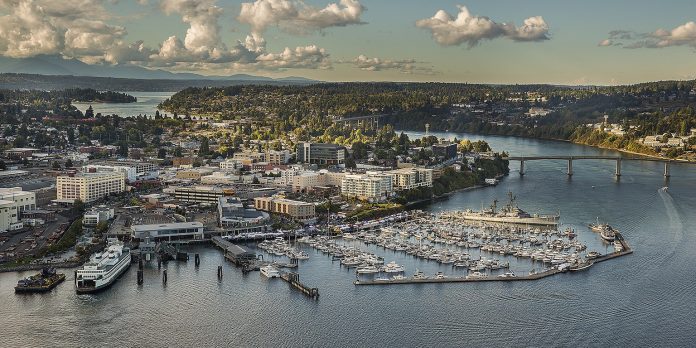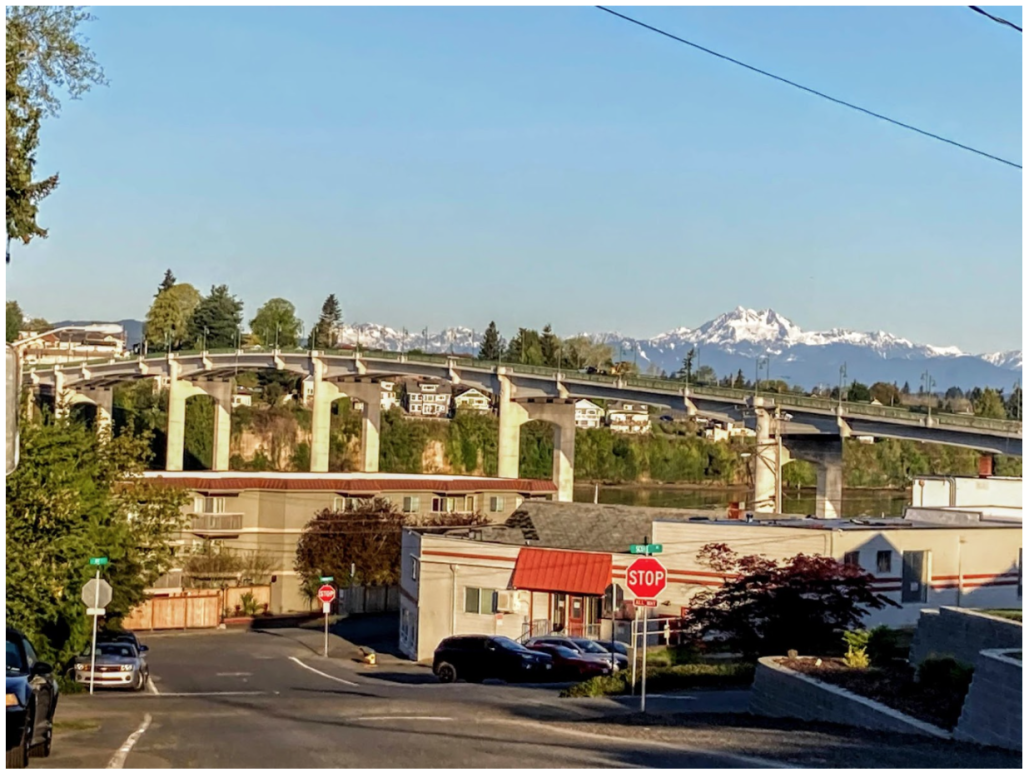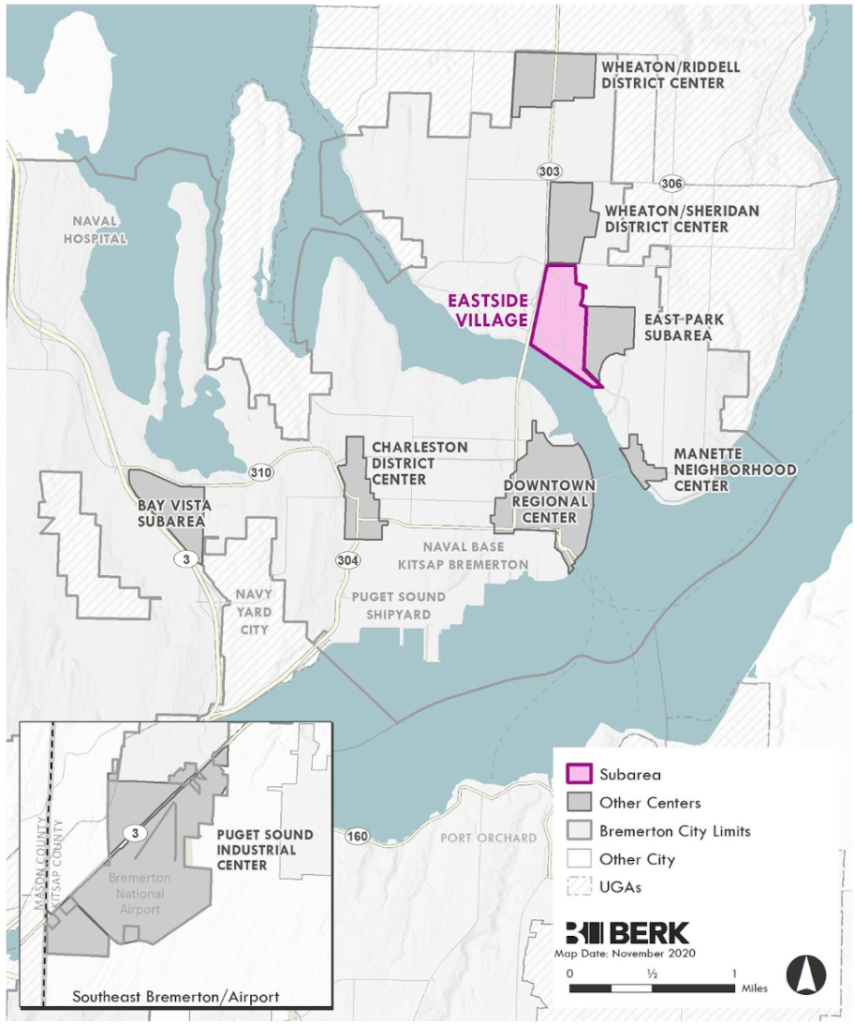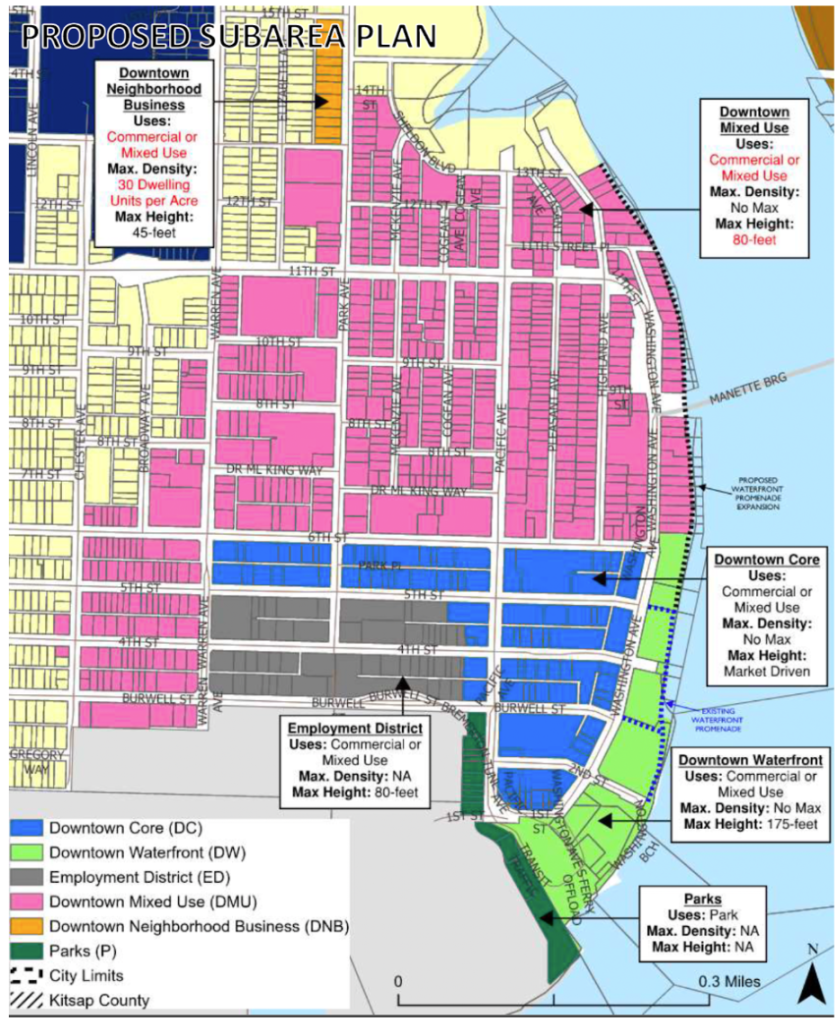
The fast-growing West Puget Sound city is considering ditching parking mandates and an upzone that could make room to add over 20,000 residents by 2044.
In its proposed 2024 Comprehensive Plan update, the City of Bremerton will determine exactly how the fast growing city can meet its ambitious housing and land use goals. The plan’s goals include creation of “compact, mixed-use development focused within [Bremerton’s] designated centers, through increased density that provides additional housing capacity,” and “supporting infill development and increased densities.”
Current city housing and land use ordinances make those goals difficult because developers are prohibited from building cost-effective, dense housing by existing code. These problematic codes enforce low housing densities, low building heights and too much parking, all of which drive up the cost of housing development and result in less needed housing being built.
The city is updating regulations for zoning, housing and parking this year and among options being considered are big increases to allowable housing types and the citywide elimination of all parking mandates.

Housing growth focused in “District Centers“
A big share of planned growth would be focused in District Centers, core neighborhoods with amenities like stores and restaurants, akin to Seattle’s “urban villages.” Created in the 2006 Comprehensive Plan, Bremerton’s District Centers have higher density limits and would attract the majority of the new housing growth and be planned to support multimodal transportation.
Three of the District Centers are located on the SR 303 corridor, a state highway that Kitsap Transit has eyed as being a prime candidate for its first bus rapid transit line. SR 303’s Warren Avenue bridge, which connects the two parts of Bremerton, is also set to receive significant multimodal investments as part of an eventual north-south bike network connecting the District Centers.

Downtown Bremerton would see the biggest changes to zoning and housing. Downtown has been designated by the Puget Sound Regional Council as a “Regional Growth Center” and is already the densest housing and employment center in the West Sound. Limitations on floor space would be eliminated, and height limits would see big increases.

In District Centers outside of downtown, the City seeks to greatly increase the allowable density of both “High Density Residential” and “General Commercial” zones. These zones would allow for the first time the highly efficient “five-over-one” building type of multi-story wood frame over one story of concrete. Density limits would be eliminated.

“Medium Density Residential” zoned areas would receive max height and other density-enabling zoning changes. All other residential neighborhoods would be upzoned to conform with the fourplex requirements in the state’s “Missing Middle Housing” law (HB 1110) passed in 2023. A 45-foot height limit is much more permissive than proposals put forward for Seattle’s lower-density residential zones and are set to allow developers more flexibility.

Taken together, the City’s housing and land use changes could allow for units able to house around 60,000 additional residents, theoretically doubling Bremerton’s population and far exceeding the anticipated growth of 20,000 new residents by 2044.
Parking mandates could vanish
As part of the Comp Plan Update, Bremerton is also considering significant updates to parking regulations. So-called General Option 2 would eliminate parking minimums for new construction, citywide or just in District Centers. This matters because parking adds to the cost of new construction projects and increase their carbon footprint. In other words, parking minimums make the lowest-cost housing illegal to build in Bremerton.
Bremerton has way too much parking, especially downtown. Despite occupying 21% of Downtown Bremerton, private parking lots average just 68% occupancy during peak parking hours.

Despite the vast oversupply of parking downtown and elsewhere, the City still requires all new housing to supply additional off-street parking. Existing parking minimums strangle low-income housing development, pushing up the cost of all types of housing, adding either expensive structured parking or large surface lots to the cost of construction. Big changes are needed if Bremerton is to meet its stated housing goals.
Some quick math: Bremerton’s growth plan expects at least 20,000 new residents, who will require about 12,000 new homes. Under current parking rules (1-2 parking spaces per dwelling), those 12,000 units require about 18,000 new parking spots (1.5 units per dwelling). The average surface parking lot requires one acre per 90 parking spaces, so Bremerton’s anticipated housing growth would require 200 acres of new surface parking. That is larger than the entire Downtown Subarea (186 acres) and 2.5 times larger than the 74-acre Seattle Center.
Existing parking minimum requirements conflict with Bremerton’s housing goals in three ways:
- Geometry – New, vast surface parking lots simply will not fit in Bremerton, especially in central Downtown and East Village neighborhoods, where Planning Director Garret Jackson projects 60% of housing growth (7,200 units) will occur. At 1.75 spots/unit, those 7,200 housing units would require 140 acres of parking, larger than 22 Walmart Super Centers.
- High cost of structured parking – Multi-story structured parking lots are very expensive to build. The Brookings Institution estimates each space adds $50,000 to multi-family housing development. In 2023, City of Poulsbo estimated $10-15 million for a 100-unit lot ($100,000+ per parking space), Sound Transit plans to build 1,482 parking spaces for $359.7 million — $240,000 per space. Increased construction cost depresses new home development and increases the cost of each new unit, in contradiction to the City’s goals.
- Prohibition of low-cost and multi-use housing types – Parking minimums effectively ban low-cost, no-parking housing types. And required first-floor parking clogs space that could otherwise be street-level retail which is the cornerstone of mixed-use, housing-over-retail development. Mixed-use development subsidizes housing by creating revenue for developers while contributing to vibrant neighborhoods.
Because parking minimums greatly increase the cost of new housing and make lowest-cost housing types illegal, an increasing number of cities — including Port Townsend, Salem, Eugene and Corvallis, Oregon — are eliminating parking minimums citywide. Other cities like Seattle, Tacoma, and Spokane have eliminated parking minimums in parts of the city well served by public transit and bike lanes. These parking minimums don’t prohibit new off-street parking – they aren’t parking bans or even parking maximums. They merely allow a homebuilder to choose how much parking to build.
The City is also considering a less ambitious option, which would modestly decrease parking minimums if certain conditions are met by the developer, such as adding bike parking or developing low-income housing. These reductions would be welcome, but aren’t enough to meet housing goals.
This wouldn’t be Bremerton’s first step to rationalize its center city parking. The 2023 Joint Compatibility Transportation Plan (JCTP) study, which was funded by the City of Bremerton and the Naval Shipyard, concluded that neither the City nor the Shipyard would permit additional parking in Central Bremerton, and instead would support alternative transportation to limit traffic growth. Eliminating parking minimums downtown and in District Centers reinforces the goals of the JCTP.
Bremerton’s Planning Commission will host a public meetings on both housing and parking use in the late spring to finalize recommendations, before the City Council takes up the topics in the summer. The City will accept public comment during those meetings, at the project website, and via email at Compplan@ci.bremerton.wa.us.


